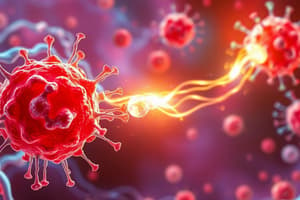Podcast
Questions and Answers
Which of the following is a key characteristic that distinguishes TI-2 antigens from TI-1 antigens in B cell activation?
Which of the following is a key characteristic that distinguishes TI-2 antigens from TI-1 antigens in B cell activation?
- TI-2 antigens are characterized by repetitive carbohydrate or protein epitopes, while TI-1 antigens activate in the absence of T cells. (correct)
- TI-2 antigens activate B cells through the innate immunity system, whereas TI-1 antigens activate B cells through T cell help.
- TI-2 antigens primarily include lipopolysaccharides (LPS), while TI-1 antigens are mainly cell wall polysaccharides.
- TI-2 antigens require direct interaction with T helper cells, while TI-1 antigens do not.
A researcher is studying B cell activation in a mouse model lacking T cells. Which type of antigen would still be capable of activating B cells in this model?
A researcher is studying B cell activation in a mouse model lacking T cells. Which type of antigen would still be capable of activating B cells in this model?
- Both TI-1 and TI-2 antigens (correct)
- TI-1 antigens only
- Thymus-dependent antigens
- TI-2 antigens only
What is the first step towards B cell activation involving thymus-dependent antigens?
What is the first step towards B cell activation involving thymus-dependent antigens?
- The B cell presents the antigen to a T helper cell via MHC I.
- The antigen directly activates the complement system.
- The B cell receptor (BCR) binds to its specific antigen. (correct)
- The antigen is phagocytosed by a macrophage.
Which of the following scenarios describes the most likely outcome when a B cell encounters a thymus-dependent antigen?
Which of the following scenarios describes the most likely outcome when a B cell encounters a thymus-dependent antigen?
Which of the following best describes the role of MHC II protein in B cell activation by thymus-dependent antigens?
Which of the following best describes the role of MHC II protein in B cell activation by thymus-dependent antigens?
A patient is diagnosed with a Streptococcus pneumoniae infection. Which type of antigen is most likely to be involved in the initial B cell response?
A patient is diagnosed with a Streptococcus pneumoniae infection. Which type of antigen is most likely to be involved in the initial B cell response?
What is the primary mechanism by which TI-2 antigens activate B cells?
What is the primary mechanism by which TI-2 antigens activate B cells?
Lipopolysaccharide (LPS) is a classical example of which type of antigen?
Lipopolysaccharide (LPS) is a classical example of which type of antigen?
Which region of an antibody molecule is primarily responsible for determining its specificity for a particular antigen?
Which region of an antibody molecule is primarily responsible for determining its specificity for a particular antigen?
Follicular dendritic cells (FDCs) play a crucial role in B cell activation by:
Follicular dendritic cells (FDCs) play a crucial role in B cell activation by:
The differentiation of B cells into plasma cells or memory cells is primarily influenced by:
The differentiation of B cells into plasma cells or memory cells is primarily influenced by:
What is the primary mechanism by which neutralizing antibodies protect against viral infections?
What is the primary mechanism by which neutralizing antibodies protect against viral infections?
Which of the following mechanisms is NOT a way antibodies contribute to suppressing infections?
Which of the following mechanisms is NOT a way antibodies contribute to suppressing infections?
The transport of IgG antibodies from the bloodstream into the extracellular space is facilitated by:
The transport of IgG antibodies from the bloodstream into the extracellular space is facilitated by:
Transcytosis of dimeric IgA antibodies across epithelial cells is mediated by which receptor?
Transcytosis of dimeric IgA antibodies across epithelial cells is mediated by which receptor?
Why is the antibody response faster and higher after the second injection of an antigen compared to the first?
Why is the antibody response faster and higher after the second injection of an antigen compared to the first?
What is the primary difference between thymus-dependent and thymus-independent antigens in B cell activation?
What is the primary difference between thymus-dependent and thymus-independent antigens in B cell activation?
Which of the following is a characteristic of mature, naive B cells?
Which of the following is a characteristic of mature, naive B cells?
What is the role of Iga and Igb proteins in B cell receptor (BCR) signaling?
What is the role of Iga and Igb proteins in B cell receptor (BCR) signaling?
How do TI-1 and TI-2 antigens activate B cells differently from antigens that require T cell help?
How do TI-1 and TI-2 antigens activate B cells differently from antigens that require T cell help?
Which of the following is NOT a primary function of B cell activation?
Which of the following is NOT a primary function of B cell activation?
What is the significance of ITAMs (Immunoreceptor Tyrosine-based Activation Motifs) in B cell signaling?
What is the significance of ITAMs (Immunoreceptor Tyrosine-based Activation Motifs) in B cell signaling?
How does the activation of B cells by thymus-independent antigens (TI) differ from activation by thymus-dependent (TD) antigens in terms of antibody isotype switching and affinity maturation?
How does the activation of B cells by thymus-independent antigens (TI) differ from activation by thymus-dependent (TD) antigens in terms of antibody isotype switching and affinity maturation?
A researcher is studying B cell activation and observes that a particular antigen stimulates B cell proliferation and antibody production without T cell involvement. Which type of antigen is most likely responsible for this observation?
A researcher is studying B cell activation and observes that a particular antigen stimulates B cell proliferation and antibody production without T cell involvement. Which type of antigen is most likely responsible for this observation?
What is the initial interaction between antigen-stimulated B cells and T helper (TFH) cells characterized by within the lymph node?
What is the initial interaction between antigen-stimulated B cells and T helper (TFH) cells characterized by within the lymph node?
What key molecular interactions mediate the strong cell-cell adhesion between TFH cells and B cells during their activation process?
What key molecular interactions mediate the strong cell-cell adhesion between TFH cells and B cells during their activation process?
Following initial activation, where do B-T cognate pairs migrate within the lymph node, and what cellular event is characteristic of each location?
Following initial activation, where do B-T cognate pairs migrate within the lymph node, and what cellular event is characteristic of each location?
Within the germinal center, follicular dendritic cells (FDCs) secrete specific cytokines that influence B cell behavior. What is the primary effect of these cytokines (IL-6, IL-15, 8D6, and BAFF) on B cells?
Within the germinal center, follicular dendritic cells (FDCs) secrete specific cytokines that influence B cell behavior. What is the primary effect of these cytokines (IL-6, IL-15, 8D6, and BAFF) on B cells?
Activation-Induced cytidine Deaminase (AID) plays a critical role in the germinal center reaction. What enzymatic activity does AID possess, and what is its direct consequence on B cell DNA?
Activation-Induced cytidine Deaminase (AID) plays a critical role in the germinal center reaction. What enzymatic activity does AID possess, and what is its direct consequence on B cell DNA?
Following somatic hypermutation in the germinal center, what determines whether a centrocyte is 'rescued' from apoptosis?
Following somatic hypermutation in the germinal center, what determines whether a centrocyte is 'rescued' from apoptosis?
How do TFH cells contribute to the function of B cells within the germinal center?
How do TFH cells contribute to the function of B cells within the germinal center?
What is the role of the variable regions of the light and heavy chains in the context of antibody-antigen interactions?
What is the role of the variable regions of the light and heavy chains in the context of antibody-antigen interactions?
Flashcards
Naive Mature B Cells
Naive Mature B Cells
Mature B cells that haven't encountered their antigen.
B Cell Receptor (BCR)
B Cell Receptor (BCR)
B cell receptors associate with Iga and Igb proteins. These have cytoplasmic tails that contain ITAMS, which interact with intracellular signaling proteins.
Thymus-Independent Antigens
Thymus-Independent Antigens
B cells can be activated by thymus-independent (TI) antigens. TI antigens do not need T cells to activate B cells.
B cell activation
B cell activation
Signup and view all the flashcards
B cell activation results
B cell activation results
Signup and view all the flashcards
Activation of B cells protects
Activation of B cells protects
Signup and view all the flashcards
B cell Life Cycle
B cell Life Cycle
Signup and view all the flashcards
Activation of B cells
Activation of B cells
Signup and view all the flashcards
TI1 Antigens
TI1 Antigens
Signup and view all the flashcards
Lipopolysaccharide (LPS)
Lipopolysaccharide (LPS)
Signup and view all the flashcards
Thymus Dependent Antigens
Thymus Dependent Antigens
Signup and view all the flashcards
TI2 Antigens
TI2 Antigens
Signup and view all the flashcards
TI2 Mechanism
TI2 Mechanism
Signup and view all the flashcards
Pneumococcal Polysaccharides
Pneumococcal Polysaccharides
Signup and view all the flashcards
T Cell Dependent B Cell Activation
T Cell Dependent B Cell Activation
Signup and view all the flashcards
Antigen Presentation by B Cells
Antigen Presentation by B Cells
Signup and view all the flashcards
B Cell and TFH Cell Interaction
B Cell and TFH Cell Interaction
Signup and view all the flashcards
TFH Cell Activation of B Cells
TFH Cell Activation of B Cells
Signup and view all the flashcards
Adhesion and Signaling
Adhesion and Signaling
Signup and view all the flashcards
B Cell Differentiation in Medullary Cords
B Cell Differentiation in Medullary Cords
Signup and view all the flashcards
Epitope Recognition
Epitope Recognition
Signup and view all the flashcards
Germinal Center Formation
Germinal Center Formation
Signup and view all the flashcards
Hypervariable Regions (HVs)
Hypervariable Regions (HVs)
Signup and view all the flashcards
Complementarity-Determining Regions (CDRs)
Complementarity-Determining Regions (CDRs)
Signup and view all the flashcards
FDC Cytokine Influence
FDC Cytokine Influence
Signup and view all the flashcards
Somatic Hypermutation Induction
Somatic Hypermutation Induction
Signup and view all the flashcards
Follicular Dendritic Cells (FDCs)
Follicular Dendritic Cells (FDCs)
Signup and view all the flashcards
Rescue from Apoptosis
Rescue from Apoptosis
Signup and view all the flashcards
B Cell Differentiation
B Cell Differentiation
Signup and view all the flashcards
FcRn Receptor
FcRn Receptor
Signup and view all the flashcards
Neutralizing Antibodies
Neutralizing Antibodies
Signup and view all the flashcards
Neutralization of Toxins
Neutralization of Toxins
Signup and view all the flashcards



